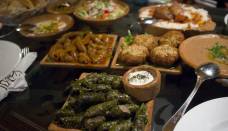In Egypt, food means pride, family, friends, charity, and life.
If there is one thing Egyptians know how to do, it is eat. Simply walk through any city in Africa’s most populous state and it is hard not to notice the abundance of eateries selling modern-day Egypt’s most typical foods. Even harder not to notice are the throngs of people gathered around the food counters eagerly anticipating their meals. The culture of eating out in Egypt is largely characterized by its fast food. The hands-down winner of the Egyptian fast food scene has to be kushari. An institution in Egypt, it is thought to be a modification of the Indian dish kitchiri brought over by British troops. Kushari consists of rice and pasta as its base, finished off with a topping of chickpeas, lentils and fried onion pieces and a drenching of tomato salsa. As meals go, it is filling, cheap, and the popular choice for many Egyptians. Other quick meals include the West’s Middle Eastern favourite: the falafel sandwich, more commonly known in Egypt as ta’amiyya, and sandwiches of foul (fava beans), liver or chicken.
Egyptians are proud of their cuisine and rejoice in introducing expatriate citizens to what Egypt has to offer. As soon as you meet an Egyptian the conversation will eventually progress to talk of food, which will soon become an invitation to eat. It doesn’t stop there; an Egyptian will invite you to at least the first couple of meals with them. With that, a new friendship is born.
In Egypt I have had the chance to eat with families and expenses are by no means spared. They are grand affairs with a spread big enough to feed a family for weeks. You are encouraged to eat as much as you can and I have more than my fill. Even though it is common for Egyptians to eat fast food, it is in the home where the true heart of food culture lies in Egypt. Indeed, when eating something on the street that is traditionally cooked in the home, Egyptians will be quick to tell that the home-cooked version is “more delicious”.
One of the best examples of Egyptians’ relationship with food is the holy month of Ramadan. In the month, Muslim Egyptians will dedicate themselves to fasting during day time hours. While Ramadan is essentially a religious event in homage to the revelation of the Holy Quran to Mohamed, it also has a special social significance. As the day nears its end, food becomes the magic word. Family and friends come together to eat the Iftar meal (breaking the fast) and it is common for many families to take turns between its members, both of the extended family and the more immediate family, to host the Iftar meal on different nights. The shared experience of food over the course of this religious occasion and its uniting force lays down the foundations for people, family, and friends to re-establish bonds that have become weak and to give thanks. At a time when Muslims are doing without what is essential for us all, the promise of a delicious meal with special dishes made for the occasion, surrounded by close ones, couldn’t elicit a happier image.
It could be said that indulgence knows no bounds and national statistics estimate every year that during the month of Ramadan Egyptians will consume three times more food than normal. As a result, production goes up and a dependence on foreign imports increases. However, Egyptians compensate this indulgence by giving unfinished food to the poor so as to not forget their fellow citizens. This outward sign of charity has also come to characterize Egyptians’ attitude toward food – everyone deserves to enjoy it.
Food and its relationship with people also has its roots in predynastic and dynastic ancient Egypt. Tomb paintings in Upper Egyptian and pyramid sites quite literally give you the picture of how ancient Egyptians used to live in terms of their habits regarding food. The land at that time was rich and luxuriant brought on by yearly inundations of the Nile. The paintings show the poorer people cultivating the land and herding cattle while the wealthier reaped the rewards with banquets of bread, beer, vegetables, beans, lentils, meat and fruits such as figs, dates, and melon. The poorer wouldn’t always lose out and paintings also show them taking part in celebrations. The central part food had in any celebration was a recognition of the enjoyment and pleasure that can be had from the finer things in life. Ancient Egyptians lived lavishly and they weren’t afraid to hide it. Even in death, burial rituals saw that the deceased would be sent to the afterlife with food in their tomb to sustain their ka (life force) in the afterlife.
We all love food; it has a way that no other thing does in bringing people together. Each culture has its own ways and habits. It is apparent that food in both modern day Egypt and ancient Egypt come to represent many things at once: celebration, relationships, lavishness and, more importantly, a sense of pride and unity. The famous 1980s song by pop-rock band The Bangles had it wrong: don’t walk like an Egyptian, eat like one!
The views expressed in this article are the author's own and do not necessarily reflect Fair Observer’s editorial policy.
Support Fair Observer
We rely on your support for our independence, diversity and quality.
For more than 10 years, Fair Observer has been free, fair and independent. No billionaire owns us, no advertisers control us. We are a reader-supported nonprofit. Unlike many other publications, we keep our content free for readers regardless of where they live or whether they can afford to pay. We have no paywalls and no ads.
In the post-truth era of fake news, echo chambers and filter bubbles, we publish a plurality of perspectives from around the world. Anyone can publish with us, but everyone goes through a rigorous editorial process. So, you get fact-checked, well-reasoned content instead of noise.
We publish 2,500+ voices from 90+ countries. We also conduct education and training programs
on subjects ranging from digital media and journalism to writing and critical thinking. This
doesn’t come cheap. Servers, editors, trainers and web developers cost
money.
Please consider supporting us on a regular basis as a recurring donor or a
sustaining member.
Will you support FO’s journalism?
We rely on your support for our independence, diversity and quality.









Comment